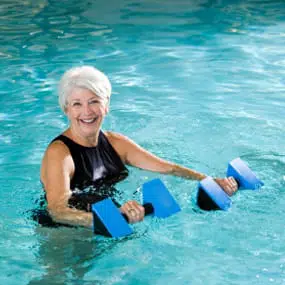The Benefits of Aquatic Exercise
March 4, 2016
There are many benefits to aquatic exercise, including physical and psychological benefits. Reaping the benefits of swimming and other aquatic activities can be valuable to a person’s overall physical and mental health. People who are recovering from an injury, have a disability, or experience stress would benefit highly from aquatic therapy.

What many people are not aware of is the fact that aquatic rehabilitation can relieve chronic pain simply because of the unique properties of water. Water is relaxing to most people but can also produce efficient workout results. Individuals with disabilities or who might have recently suffered an injury can reap the benefits of aquatic therapy by utilizing a swimming pool chair lift in order to access a pool.
Here are the benefits to participating in aquatic exercise:
Whole Body Workout
Aquatic exercise conditions the entire body. Swimming can tone your body and it works to condition almost all of the muscle groups. Swimming freestyle, breaststroke or backstroke are all aquatic exercises that work to condition your body. Swimming also improves flexibility and endurance.
If you’re interested in aquatic exercise in regards to weight loss, swimming can provide you with the best aerobic workout for your body. Like any exercise, the amount of calories burned depends upon the swimming routine, workout intensity, conditioning level, and your metabolism.
Prevent Overheating
Water disperses heat better than air. Pool water can cool you off easier than if you were to run outside for an hour in the sun. Aquatic exercise is simply cooler on the body and much more comfortable.
Low Risk of Injury
When exercising in the water, there is a much lower risk of injury. Aquatic exercise does not put stress on your bones or joints due to the water’s buoyancy. People also weigh 1/10th less in the water, meaning you can support your body weight easier.
Taking part in aquatic therapy also has low-impact results, meaning swimming can prevent future injuries as well. Aquatic exercise is recommended for women who are pregnant because swimming strengthens the shoulder and abdominal muscles which are areas pregnant women experience the most strain. Elderly people or people who might have suffered from a recent injury might also turn to aquatic therapy because of its low-impact. Swimming can help relax stiff muscles and increase circulation.

Prevent High Blood Pressure
Aquatic exercise can lower blood pressure. According to the American Journal of Cardiology, elderly swimmers had better overall blood pressure results. Because of its low-impact on joints and muscles, aquatic exercise doesn’t raise blood pressure easily. In fact, swimming lowers blood pressure because of the water’s relaxing qualities.
Stress Relief
Additionally, aquatic therapy can benefit you psychologically. There are meditative and healing properties of water which can promote stress relief and enhance your overall attitude. Even a quick swim before work can provide you with clarity to start your day. Getting in the water is simply a fun activity, which is why it’s recommended to boost mood.
All of this is a result of oxygen flowing throughout your body. As mentioned, swimming promotes blood circulation, so more oxygen is flowing to your muscles, forcing you to regulate your breathing.
